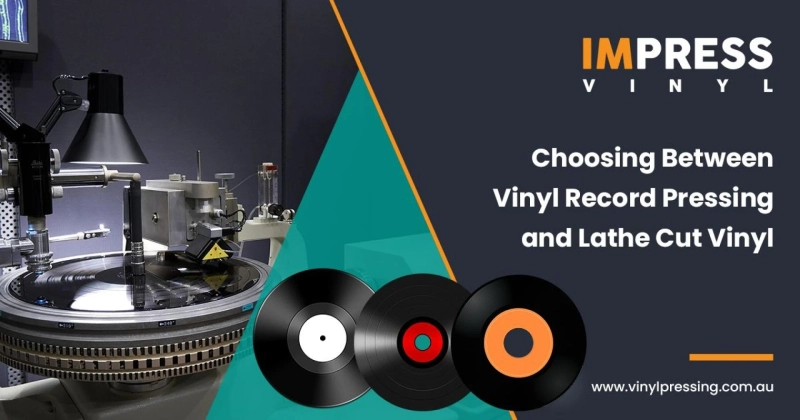Vinyl records have made a remarkable resurgence in recent years, appealing to both audiophiles and collectors with their rich sound quality and tangible format. If you're an artist or producer looking to release your music on vinyl, you may be weighing your options between vinyl record pressing and lathe cut vinyl. Each method has its unique characteristics, benefits, and drawbacks. Understanding these differences can help you make an informed decision about which is the best fit for your project.
What is Vinyl Record Pressing?
Vinyl record pressing is the traditional method of manufacturing vinyl records. This process involves several steps:
Mastering: The audio is first mastered specifically for vinyl to ensure optimal playback.Creating the Lacquer Master: A lacquer master disc is cut using a lathe. This master contains the grooves that will eventually be pressed into the vinyl records.Electroplating: The lacquer master is then coated with metal to create a stamper.Pressing: Vinyl pellets are heated and molded into discs using the stamper, creating multiple copies of the record.Advantages of Vinyl Record Pressing
High-Quality Sound: Pressed vinyl records are known for their superior sound quality, with deeper grooves that can capture more detailed audio.Durability: Pressed records are generally more durable and can withstand repeated plays without significant degradation.Mass Production: This method is ideal for producing large quantities of records, making it cost-effective for big releases.Standard Format: Pressed records are compatible with all standard turntables and play consistently across different systems.Disadvantages of Vinyl Record Pressing
Cost: The initial setup costs, including mastering and creating the stamper, can be high. This makes pressing less economical for small runs.Time-Consuming: The process is lengthy, often taking several weeks to complete, which can delay the release of your music.Minimum Order Quantities: Many pressing plants require a minimum order, which can be a barrier for independent artists or small labels.What is Lathe Cut Vinyl?
Lathe cut vinyl records are created by cutting grooves directly into a blank vinyl disc using a lathe. This method is typically used for short runs or custom records.
Advantages of Lathe Cut Vinyl
Flexibility: Lathe cutting is ideal for small runs, often as few as one record. This makes it perfect for limited editions, promos, and personalized records.Quick Turnaround: Without the need for electroplating and pressing, lathe cuts can be produced relatively quickly, sometimes within days.Lower Upfront Costs: Since there is no need for a lacquer master or stamper, the initial costs are lower, making it accessible for independent artists.Customization: Lathe cut records offer a high degree of customization, allowing for unique shapes, sizes, and personalized messages in the dead wax.Disadvantages of Lathe Cut Vinyl
Sound Quality: Lathe cut records often have lower sound quality compared to pressed vinyl. They may have higher surface noise and less dynamic range.Durability: These records are generally less durable and can wear out faster with repeated play.Playback Compatibility: Lathe cut records may not be compatible with all turntables. Some turntables with lightweight tonearms or automatic return features might struggle to play these records properly.Limited Scalability: While perfect for small runs, lathe cutting is not cost-effective for larger quantities due to the time-intensive nature of individually cutting each record.Choosing the Right Method for Your Project
Deciding between vinyl record pressing and lathe cut vinyl depends on several factors, including your budget, the quantity you need, the desired sound quality, and the purpose of the release.
Consider Your Budget
Low Budget: If you have a limited budget and only need a small number of records, lathe cutting is likely the better option. The lower upfront costs and flexibility for small runs make it ideal for independent releases and special editions.Higher Budget: If you have a higher budget and plan to produce a large quantity of records, vinyl pressing is more cost-effective in the long run despite the higher initial setup costs.Think About Quantity
Small Runs: For runs of fewer than 100 records, lathe cuts are more practical and affordable. They allow you to test the market or create exclusive products without a significant financial commitment.Large Runs: For runs over 100 records, vinyl pressing becomes more economical. The per-unit cost decreases with higher quantities, making it suitable for mass production.Evaluate Sound Quality
High Sound Quality: If sound quality is your top priority, vinyl pressing is the preferred method. Pressed records provide a fuller, richer sound that is more faithful to the original recording.Acceptable Quality: If you can tolerate a bit of surface noise and slightly lower fidelity, lathe cuts can still deliver a satisfactory listening experience, especially for genres that benefit from a raw, lo-fi aesthetic.Purpose of the Release
Commercial Release: For a commercial release intended for wide distribution, vinyl pressing is the best choice due to its durability and compatibility with all standard turntables.Limited Editions and Collectibles: For limited editions, promotional items, or personalized gifts, lathe cut records offer a unique and customizable option that can create a sense of exclusivity and personal connection.Conclusion
Both vinyl record pressing and lathe cut vinyl have their unique advantages and are suited to different needs. Vinyl record pressing is ideal for high-quality, durable records in large quantities, while lathe cut vinyl offers flexibility, lower initial costs, and quick turnaround for small runs. By considering your budget, the desired quantity, sound quality, and the purpose of your release, you can choose the method that best aligns with your goals and resources. Whether you opt for the traditional route of pressed vinyl or the bespoke appeal of lathe cuts, you'll be able to bring your music to life on vinyl and offer listeners a tangible, timeless piece of art.


